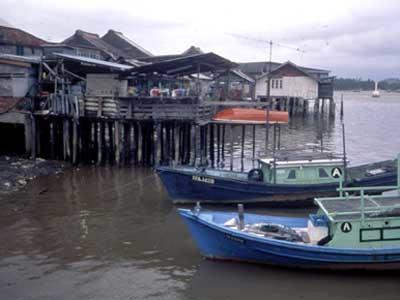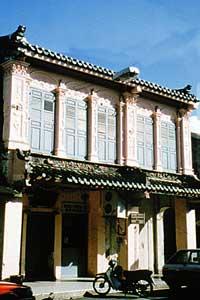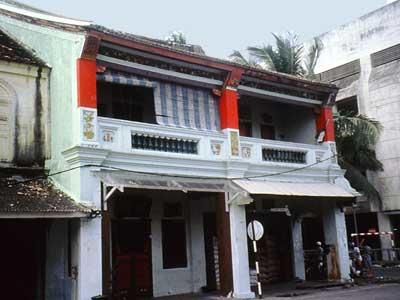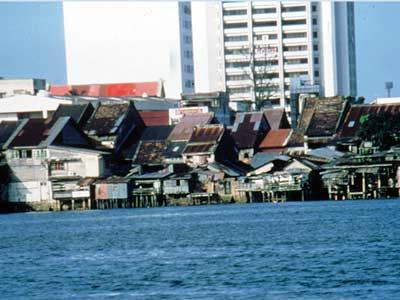A line of modest wooden buildings follows the gently curving waterfront at Kampung Cina, the oldest street in what is now one of Malaysia’s largest cities, Kuala Terengganu. When these traditional Chinese shop houses were built in the late 19th century, they functioned as both homes and businesses. Kampung Cina’s proximity to the water is central to its identity. Situated in northeastern Malaysia where the Terengganu River empties into the South China Sea, the city functioned as a trading post for textiles, pepper, and gold between Eastern Asia and the West. The architecture of the shop houses charts evolving fashions into the 20th century: the earliest buildings are simple, single-story structures, but later they accumulate impressive plaster and ceramic decoration, art deco motifs, and fine river gates that open onto the water. Many were the property of local officials who were engaged at the palace of the Terengganu Sultan located nearby. The Kampung Cina houses remain occupied and intact but Kuala Terengganu has been modernizing around them, causing tension between developers and preservationists.
1998, 2000 and 2002 World Monuments Watch
Although Kampung Cina has maintained its character since the late 19th century, many of its buildings are deteriorating. In addition to natural deterioration, illegal jetties have been installed along the waterfront that lower the water level and create unsightly collections of trash. The government, hoping to encourage tourism, proposed demolishing the shop houses, the old Terengganu Palace, and nearby Malay villages and replacing them with new small stores. The authorities further inflamed the situation by repealing rent control on the houses in the area. WMF placed the Kampung Cina River Frontage on the Watch list in 1998, 2000, and 2002 to advocate for the preservation of Malaysia’s historic waterfront district. In 1998, WMF funded research for Badan Warisan Malaysia (Heritage of Malaysia Trust) to develop a plan to improve the current shop structures. By 2000, the organization had prepared a conservation outline for a pilot project on No. 51/53 Jalan Bandar, to update its roof and façade. Badan Warisan Malaysia also created a video to encourage the local community and others to take part in the preservation effort and has continued its work to reintegrate Kampung Cina into the rest of the city.
The Kampung Cina River Frontage represents the history of Kuala Terengganu and its relationship with the water. Skyscrapers now form the backdrop of the waterfront due to modernization of the city, which has brought development and increased tourism. The government’s plan to raze the traditional shop houses (which are still inhabited) chooses economic growth over cultural heritage, but the two concepts do not have to be mutually exclusive. By revitalizing Kampung Cina and upgrading the capabilities of the traditional structures, both growth could be accomplished while a unique way of life is preserved.




